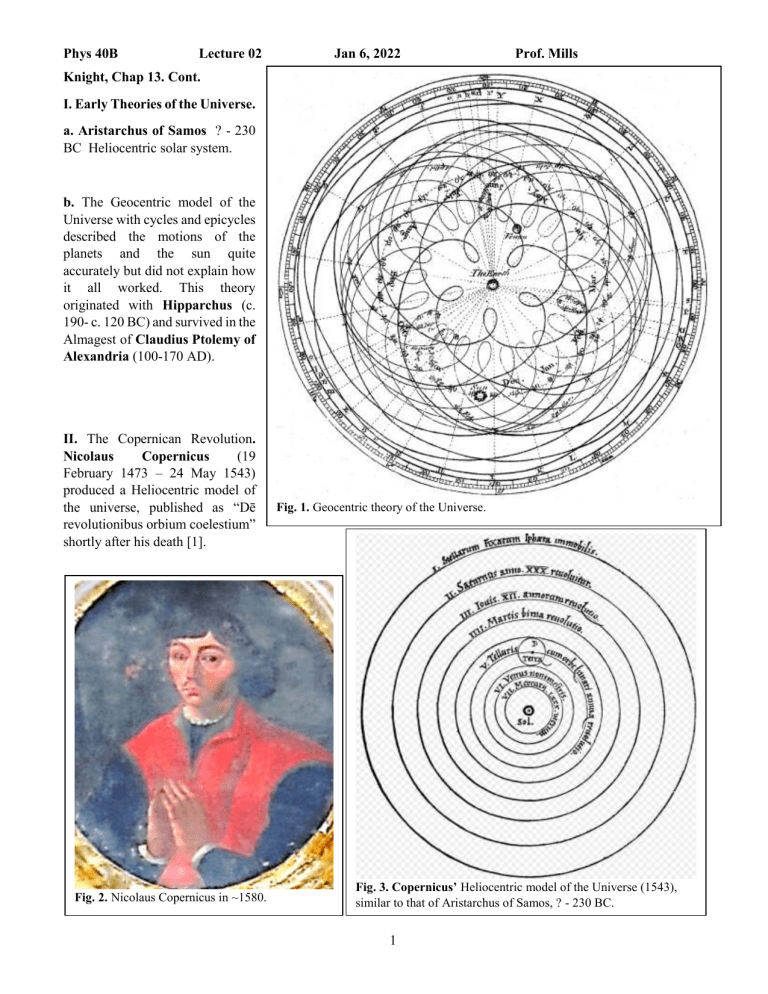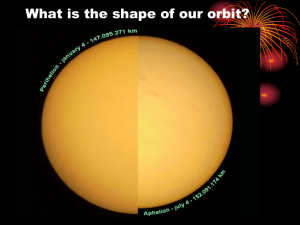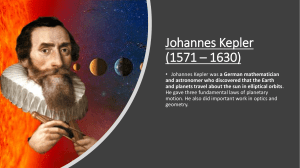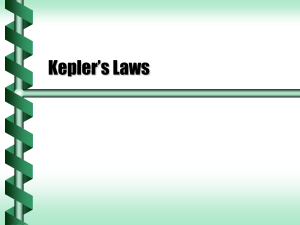
Phys 40B Lecture 02 Jan 6, 2022 Prof. Mills Knight, Chap 13. Cont. I. Early Theories of the Universe. a. Aristarchus of Samos ? - 230 BC Heliocentric solar system. b. The Geocentric model of the Universe with cycles and epicycles described the motions of the planets and the sun quite accurately but did not explain how it all worked. This theory originated with Hipparchus (c. 190- c. 120 BC) and survived in the Almagest of Claudius Ptolemy of Alexandria (100-170 AD). II. The Copernican Revolution. Nicolaus Copernicus (19 February 1473 – 24 May 1543) produced a Heliocentric model of the universe, published as “Dē revolutionibus orbium coelestium” shortly after his death [1]. Fig. 2. Nicolaus Copernicus in ~1580. Fig. 1. Geocentric theory of the Universe. Fig. 3. Copernicus’ Heliocentric model of the Universe (1543), similar to that of Aristarchus of Samos, ? - 230 BC. 1 a. Tycho Brahe (14 December 1546 – 24 October 1601) - Tycho proposed a hypothetical (non-empirical) "geoheliocentric" system, but did not allow this to prevent him from making thousands of highly accurate (±2 arc minutes) measurements of the positions of the stars and planets on the heavenly sphere of the fixed stars at different times over a period of 30 years using lensless instruments like the sextant shown in Fig. 3. Fig. 4. Drawing of a large (~2 m?) sextant used by Tycho Brahe (1546 – 1601) [Quelle: Deutsche Fotothek] for determining the position of stars and planets on the celestial sphere. The Altitude, the angle between an object and the observer’s local horizon, is measured from the angle of the movable stick N on the curved scale BC when the light from a star-like object in the sky passes through two apertures A and M affixed to the ends of N. The Azimuth is the angle of the object around the horizon measured eastward from true north. The vertical direction of the apparatus is fixed by a plum line LK. Since there is no means for adjusting the orientation of the apparatus about the vertical axis, I suppose that the direction AB is pointing due north and that all the measurements are made at the exact moment that the object comes into view. The recorded data would then be the star or planet’s name, date, time, and altitude. From 30 years of Tycho Brahe’s measurements, Johannes Kepler (1751 – 1630) deduced his three laws: I. II. III. A planetary orbit is an ellipse with the sun at one of its two foci. A line joining a planet and the sun sweeps out equal areas in equal time intervals. The orbital of period of a planet is proportional to the 3/2 power of the semi-major axis of its orbit. 2 Appendix on the necessity of unbiased gathering of information to arrive at the truth – the scientific method. Barbara McClintock’s (June 16, 1902 – September 2, 1992) and her favorite microscope preserved at the Smithsonian Museum. She was awarded the Nobel Prize in 1983 for the discovery of jumping genes (transposable elements) in maize. Barbara McClintock said “Really believe your data”, not meaning that you should believe in meaningless numbers, but that if you have obtained data on a hitherto unknown system carefully, faithfully and without making anything up or fiddling with the numbers, you can rely on the data to tell you something true about nature. In her case, the data told her about a new mechanism by which cells modify themselves in response to stresses by moving genetic material from one location to another. This mechanism is of obvious current interest. In the case of Tycho, he did not live long enough to use his vast amount of data on star positions, but his successor Kepler took the positions at face value and arrived at the correct heliocentric model of the local universe. Barbara McClintock (1902-1992) used this microscope in the 1940s and 1950s for research on transposing genetic elements or “jumping genes” in maize. In this process, segments of DNA jump from one location on a chromosome to another. When Dr. McClintock published her results, she met with skepticism from many fellow geneticists. However, in 1983 she was awarded the Nobel Prize for her work. It was eventually determined that these elements are found in virtually all living organisms. This instrument, made by Bausch & Lomb Optical Co., is fitted with a circular mechanical revolving stage designed specifically for photomicrography. Dr. McClintock gave the microscope, and its set of apochromatic lenses, to Dr. Joseph C. Gall of the Carnegie Institution in Washington, D.C. in the summer of 1977. She told him she no longer needed it and wanted it to be in safe hands. In 1993 the Carnegie Institution donated the instrument to the Smithsonian Institution. Other quotes by Barbara McClintock: “I was just so interested in what I was doing I could hardly wait to get up in the morning and get at it. One of my friends, a geneticist, said I was a child, because only children can't wait to get up in the morning to get at what they want to do. “I start with the seedling, and I don't want to leave it. I don't feel I really know the story if I don't watch the plant all the way along. So I know every plant in the field. I know them intimately, and I find it a real pleasure to know them. “Every time I walk on grass, I feel sorry because I know the grass is screaming at me. “With the tools and the knowledge, I could turn a developing snail's egg into an elephant. It is not so much a matter of chemicals because snails and elephants do not differ that much; it is a matter of timing the action of genes. “You don’t have to imitate others.” 3 III. Kepler’s Laws. Johannes Kepler (27 December 1571 – 15 November 1630) was Tycho’s assistant from 1600-1601. Working under Tycho’s direction, Kepler began the analysis of the orbit of Mars. In 1604 he discovered that, out of the many possible orbital shapes he tried, an elliptical orbit most accurately fits the Mars data with its almost 10% eccentricity, and concluded his first law: 1. The planets move in an elliptical orbits (the orientation of which is fixed in space) with the sun at one of the foci of the ellipse. This is only true for central forces that are proportional to 1/r2 and for which the Laplace-Runge-Lenz vector (see Fig. 5), A p L mkrˆ , Fig. 5. The LRL vector A (shown in red) at four points (labeled 1, 2, 3 and 4) on the elliptical orbit of a bound point particle moving under an inverse-square central force. The center of attraction is a small black dot. is a constant of the motion [2]. An elliptical orbit (see Fig. 6) is given by r a(1 e2 ) / (1 e cos ) [3], where r is the distance from the center of the planet to the center of the sun, e is the eccentricity of the orbit, and a is the length of the semimajor axis. Fig. 6. Elliptic orbits. The second law is a consequence of the conservation of angular momentum for a radially directed force: 2. A line drawn between the centers of the sun and of a planet sweeps out equal areas in equal times. The concepts of angular momentum and its conservation were not known at the time. 4 In 1619, Kepler used the planetary data (derived from Tycho’s measurements) for the length of the semimajor axis, a, and the orbital period in days, T, in the left portion of the following table to derive his empirical third law: 3. The square of a planet’s orbital period is proportional to the cube of the length of the semimajor axis of its elliptical orbit. Fig. 7. Kepler and modern planetary orbital semi-major axes and periods showing that a3/T2 = const. https://en.wikipedia.org/wiki/Kepler%27s_laws_of_planetary_motion#/media/File:Solar_system_orbital_per iod_vs_semimajor_axis.svg Upon finding that R3/T2 is the same for all planets, Kepler wrote: “I first believed I was dreaming... But it is absolutely certain and exact that the ratio which exists between the period times of any two planets is precisely the ratio of the 3/2 power of the mean distance. Translated from Harmonies of the World by Kepler (1619) [4]. The log-log plot of the periods of the planets and two planetesimals in Fig. 8 demonstrates the validity of Kepler’s third law. It is important to notice that the period of a planet does not depend on the eccentricity of its orbit, but only on the length of its semimajor axis and the mass of the sun. It is interesting that a particle moving in a 1/r2 central force possesses a c. Galileo Galilei (15 February 1564 – 8 January 1642) saw four moons orbiting Jupiter and proposed that objects falling in vacuum under the influence of gravity have an acceleration that is independent of the composition of the objects. This observation promoted the credibility of the heliocentric theory of the planets. 5 Fig. 8. Graphical proof of Kepler’s Third Law. https://upload.wikimedia.org/wikipedia/commons/b/be/Sol ar_system_orbital_period_vs_semimajor_axis.svg IV. The Laws of Isaac Newton (4 January 1643 – 31 March 1727) a. Universal gravitation. Every particle attracts every other particle in the universe with a force that is (i) directly proportional to the product of their inertial masses, (ii) inversely proportional to the square of the distance between their centers, and (iii) directed along a straight line joining the two centers. This law is precisely true only for spherically symmetric masses. Fig. 9. Cavendish balance for measuring the mass of the earth and the gravitational constant G. Two 51 mm diameter (0.73 kg) lead spheres are suspended from a 1.8 m horizontal wooden rod m. Two large spheres W attract the little spheres which deflected about 4 mm due to the attraction of the two large masses. b. Tests of universal gravitation. The balance shown in Fig. 9 enabled Henry Cavendish (10 October 1731 – 24 February 1810) [5] to measure the equivalent of Newton’s gravitational constant G = 6.74×10−11 m3 kg–1 s−2, now known to be (6.67430±0.00015)×10−11 m3 kg−1 s−2 [6]. Modern measurements of G exhibited in Fig. 10 exhibit variations much larger than expected based on careful estimates of the known errors. However, modern measurements of the motions of planets, artificial satellites, double pulsars, collapsing black hole pairs, emission of gravity waves, etc. confirm the correctness of not only Newton’s law of universal gravitation but also the corrections to this law based on Einstein’s theory of gravitation. Fig. 10. Sixteen modern measurements of G. 6 c. Newton’s three laws of motion 1. A body continues in its state of rest, or in uniform motion in a straight line, unless acted upon by a force. 2. A body acted upon by a force moves in such a manner that the time rate of change of momentum, p mv , equals the force F : dp F dt More simply stated (if the mass is a constant), we have the familiar relation F minert a , where minert is said to be the inertial mass of the body, and dv a dt Fig. 11. Isaac Newton. 3. If two bodies exert forces on each other, these forces are equal in magnitude and opposite in direction. The laws of gravitation and the laws of motion were published in Newton’s Philosophiæ Naturalis Principia Mathematica (Mathematical Principles of Natural Philosophy), first published in 1687. d. The principle of equivalence: The inertial mass of an object and the mass that determines its weight at the earth’s surface are the same, minert mgrav . e. Strong equivalence principle: All the laws pertaining to freely falling particles are the same as they are in an unaccelerated reference frame. f. The law of conservation of momentum was first correctly stated by John Wallis around 1670 [7]: “the initial state of the body, either of rest or of motion, will persist” (if the body is not acted upon by an external force). g. The law of conservation of angular momentum for central forces is inherent in Kepler’s second law (a planet sweeps out equal areas in equal times), and was shown to be true for any central force by Newton. That this law and other conservation laws follow in general from the symmetry (the symmetry of the Lagrangian) of a problem was shown by Noether’s theorem [8], “one of the most important mathematical theorems ever proved in guiding the development of modern physics” [9], by Emmy Noether (23 March 1882 – 14 April 1935). The angular momentum L of a particle about a given origin is defined as: L r p, where r is the position vector of the particle relative to the origin, p is the linear momentum of the particle, and denotes the cross product. Fig. 12. Emmy Noether 7 Theorem: If the only forces present are in the radial direction, then L r p is a constant of the motion. dr . dt dL dr dr d 2r Take the time derivative of both sides of this equation: m mr 2 . dt dt dt dt Proof: Rewrite the angular momentum as L r m The first term on the right is zero because the two vectors are parallel; the second term is zero because the acceleration is parallel to the force which is parallel to the radius vector. Therefore L r p is a constant of the motion when there are only radial forces present. Fig. 13. Orbits of various satellites. Hohmann transfer orbit for getting to the orbit of another planet, Molniya orbit and Tundra orbit, for surveying a certain spot on Earth, and (not shown) a geosynchronous orbit with a period of 23 h 56 m 4 s (one sidereal day) which hovers forever at 35,786 km above sea level. over the same spot on the equator. Fig. 14. Computer generated image of locations of known space debris, showing the heavily populated geosynchronous orbit at 35,786 km above sea level and the low earth orbit junk yard. https://en.wikipedia.org/wiki/Geosynchronous_orbit#/me dia/File:Debris-GEO1280.jpg 8 [1] https://en.wikipedia.org/wiki/Nicolaus_Copernicus [2] https://en.wikipedia.org/wiki/Laplace%E2%80%93Runge%E2%80%93Lenz_vector [3] http://hyperphysics.phy-astr.gsu.edu/hbase/Math/ellipse.html [4] https://en.wikipedia.org/wiki/Kepler%27s_laws_of_planetary_motion [5] https://en.wikipedia.org/wiki/Henry_Cavendish [6] https://www.nist.gov/programs-projects/precision-electro-mechanical-experiments-preme [7] John Wallis, Mechanica sive De Motu, Tractatus Geometricus (1670). [8] Emmy Noether, "Invariante Variationsprobleme". Nachrichten von der Gesellschaft der Wissenschaften zu Göttingen. Mathematisch-Physikalische Klasse. 1918: 235–257 (1918). [9] Lederman, Leon M. and Hill, Christopher T. (2004), Symmetry and the Beautiful Universe, Amherst, MA: Prometheus Books, ISBN 978-1-59102-242-8 9




